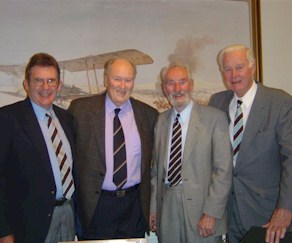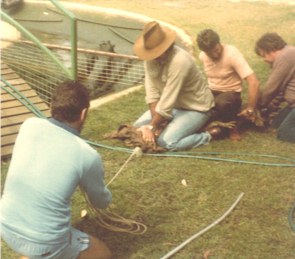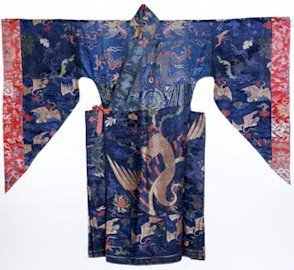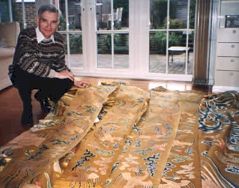Some of these articles will appear in the Yearbook that is due out in Winter 2005. It has been tough editing all the correspondence with the much-reduced space available in the Yearbook; but the nice thing about the website, is that I can publish most correspondence in full. News ranges from crocodile taming in Queensland to Al Jazeera International in Qatar.
Although I do send out email reminders of the editorial deadlines, I know that not all of you have email or internet (if you do have email, then please register on the website as it assists communication enormously). A quick check of numbers shows a total of 380 overseas OFs (and I suspect that the real total might exceed 400 if we could count all those overseas but without contact addresses, such as recent Hong Kong leavers); but only 230 of you have email addresses, and only 120 of those have registered on the website. For those of you overseas but without email, I am still very keen to hear your news – by mail, friend’s email, fax, phone or whatever. Please remember that my editorial deadlines are end of February for the Newsletter and end of September for the Yearbook – but we can publish anytime on the website. Do send your news, especially photographs. I look forward to hearing from you.
For “technical reasons”, this web edition of the Overseas Bag has had to be split into two parts:
Introduction plus Australia to China (including Hong Kong)
Rest of the World – France to USA
AUSTRALIA
 A Brisbane Gathering took place on 27th May 2005 in the United Services Club with (see photo – l to r): Neville Marsh (S53-61), John Gates (S44-48), Peter Simpson (K32-40), Peter Bailey (K34-38) and accompanied by their wives.
A Brisbane Gathering took place on 27th May 2005 in the United Services Club with (see photo – l to r): Neville Marsh (S53-61), John Gates (S44-48), Peter Simpson (K32-40), Peter Bailey (K34-38) and accompanied by their wives.
The original gathering had planned to include Captain Nick Carlton (G63-70) but due to a change in his work schedule, he was unable to attend. Nick captains the P&O Cruise liner ss Pacific Sky; and as a result has started an unofficial “OF Cruise Club” of OFs who have been on one of his cruises. The “club” now includes Bryan Pearson (S45-47), Peter Simpson and John Gates – all of whom have spoken very favourably of their time on board. John Gates said that his group visited the Bridge 2 or 3 times during their cruise and that he was on the Bridge as they came down Bris River & whilst docking at 5am on 22 January 05.
Similarly, Chris Bartlett (K60-66) had taken on the mantle of organising the next Perth OF gathering. Since Nick Carlton has relocated from UK to live at Secret Harbour, near Perth, Chris has suggested that this might be a good reason to get things in motion for another OF Perth Dinner.
Neville Marsh reports that he has been busy writing a brief history of the “Fram Flyer” to go into Clive Hedley’s compilation of Suffolk stories. In the process I came across Canon David Pitcher (R44-51) who has written a much longer history “All Change for Framlingham” (David Pitcher has given the website team an electronic copy of this book, so we are hoping to find a way to publsh it). We hope to reproduce Tony Hoolahan’s great photograph of Fram boys on the steam engine which appeared in the Sept 1992 Mag.
 Chris Shaw (K50-56) sent in a couple of photos from a “few” years ago in which he seems to be trying to prove that he was the original “Crocodile Hunter”. Chris also sent in a long story “The Crocodile Smile” to accompany the photos which are attached below. In the photo, Chris is the furthest from the croc, with his back to the camera, hanging onto the rope. The second photo shows Chris hoping that he has correctly identified a tame black-headed python rather than one of Australia’s many highly venomous snakes. Apparently the snake did try to get over-friendly and threw a couple of “love squeezes” around his neck before assistants rescued him from the amorous embrace. Chris says he still visits Zookeeper friends, so gets to go “behind the scenes” to handle snakes and crocodiles.
Chris Shaw (K50-56) sent in a couple of photos from a “few” years ago in which he seems to be trying to prove that he was the original “Crocodile Hunter”. Chris also sent in a long story “The Crocodile Smile” to accompany the photos which are attached below. In the photo, Chris is the furthest from the croc, with his back to the camera, hanging onto the rope. The second photo shows Chris hoping that he has correctly identified a tame black-headed python rather than one of Australia’s many highly venomous snakes. Apparently the snake did try to get over-friendly and threw a couple of “love squeezes” around his neck before assistants rescued him from the amorous embrace. Chris says he still visits Zookeeper friends, so gets to go “behind the scenes” to handle snakes and crocodiles.
Chris says he is in regular contact with Peter Hughes (G52-56) who also lives in the Cairns area. Both of them recently reluctantly retired from the UK Register of Pharmaceutical Chemists, but continue to do Locum work around the Cairns area, occasionally in tandem! Chris has also set up a distribution business, a branch of the parent company in North Wales, with goods allied to his Pharmacy career. Peter, always an actor, appears regularly in Cairns Little Theatre productions at the Rondo Theatre, which produce ‘little gems’ with considerable expertise and professionalism.
Peter says that the photo on the website of the ’65 Hancock try brought memories of a group at Fram, including Andy Hancock (S52-57), ‘Ern’ Ashon (G52-56) and Dave Summers (G48-56), who at one time all frantically tried to ‘bulk-up’ their musculature by following a Charles Atlas programme! Andy, apparently, was the only one to succeed.
Chris wishes to send regards to Paul Williman (K51-57), Clive Simpson (K49-53), Mike Craven (S50-56), Peter Smallpeice (K49-57), and Roger Stearn (K53-57) and his sisters. My condolences go to Peter Jay (K49-56) for the passing of his lovely Mum, whose beauty and charm Chris well remembers on trips to and from Felixstowe in their car.
 The Crocodile Smile – By Chris Shaw. In 1982 a good friend of mine, Ken Bullen, was the Curator of Animals at the local Zoo some miles north of Cairns, Queensland. Ken suggested that we got together with some local ‘herps’ meaning Herpetologists, those people who have an interest in, or even study, snakes, lizards, frogs and so on. Yes! There are such people, but in truth, they’re a bit thin on the ground.’
The Crocodile Smile – By Chris Shaw. In 1982 a good friend of mine, Ken Bullen, was the Curator of Animals at the local Zoo some miles north of Cairns, Queensland. Ken suggested that we got together with some local ‘herps’ meaning Herpetologists, those people who have an interest in, or even study, snakes, lizards, frogs and so on. Yes! There are such people, but in truth, they’re a bit thin on the ground.’
So, with a trained Herpetologist, Bill Hosmer, who had spent some time studying at the Natural History Museum in Chicago, we three formed the Cape York Herpetological Society. The roles naturally fell to Bill as President, Ken as the active Member out there doing things, and me, as a Pharmacist who could shut up, and read and write, as Secretary.
We use to meet on one evening a month, usually under someone’s house. ‘Under the house’ because in the wet tropics of North Queensland, most houses are built on stumps or poles over seven feet or two metres plus off the ground. With the amount of rainfall in a normal wet season, the good old bungalow can be expected to have water about half way up its walls for a fair bit of the time. It tends to ruin the books and the carpet, and the Missus misses out on her soaps! So, ‘under the house’ means that it’s cool, it’s private and everyone has a beer fridge down there, so with a table and some chairs we were set.
‘Yes! Of course upstairs in the Wet!’
A few people turned up from time to time. Some, like me, with not much clue about any part of the subject matter. Others, who had their own collections of snakes or whatever, could discuss this particular form of animal husbandry intelligently. There were some strange things that came in to conversation, like the constant referral to the ‘beauty’ of snakes, their colour patterns and their patina. I don’t recall being overly impressed with the appearance of any snakes at any time, but like everything else, keep an open mind, look and listen.
One fellow told us that he had got back to his caravan rather late one night and somewhat in his cups, and thought it would be a good idea to kiss his pet ‘Death Adders’ goodnight! Naturally, one of them bit him-on the tongue! He sobered up really fast and estimated that he had about half an hour to unconsciousness, and it was a 40 minute drive to the Hospital. Apparently he made it, just! Then, imagine trying to explain to a weary and very cynical old Staff nurse, that you had been a very silly boy, you wouldn’t do it again, but that right now you needed help! As an added hindrance, of course, his tongue had swelled to fill his mouth! When sign language failed, he had to resort to writing, which was apparently not his strongest suit, but the message was eventually received and he was resuscitated. It was a toss-up as to which hurt most afterwards, the hangover or the snake-bite!
My only contribution in the snake story stakes was about the seven little bantams I had bought and built a pen for. They were down to four before I became aware of their dwindling numbers. I found the culprit, a huge python with lumps in it! So I did what the prevailing folk-lore of North Queensland told me to do; I dealt it a severe blow with my machete.
‘Yes! Everyone has one! Tch! And yes I got booed at the meeting!’ Only to be expected really, given the company!
However, now down to two bantams and finding another huge look-alike predator, this time I had the sense to call the local Zoo, and after closing time they came to collect this monstrous snake! Well, actually, she came to collect it; blonde and eighteen, if that, six stone soaking wet, slim, long hair, no nerves! Then, she asked me to hold the sack! Oh! God! That was the reason I called you, so I wouldn’t have to be within ten feet or more of it! This, while she fed 16 feet of coiled terror in, tied it, threw it over her shoulder, thanked us and went about her business! Weaker sex! Huh! I’m glad they have the babies; otherwise the race would have been extinct by now!
It was in those early days of the Society that we had a visit from Hal Cogger, who had written THE book on Australian Herpetofauna, with all its keyed guides to the identification of individual species. He was impressed with our little club. Bill had had a skink named after him, Egernia hosmeri, and Ken kept up a dialogue of Zoo-keeping husbandry, both in Australia and overseas. I kept the beer flowing seamlessly-a useful role at last. All in all, a great evening.
It was soon after that meeting that I received a phone call from Ken. It was 6.30am on a Sunday morning and I was not happy! I asked him what he wanted and he said he needed me at the Zoo but wouldn’t say why. So at 6.45am I arrived in full North Queensland gear, dress-thongs, shorts and T-shirt bearing a suitable logo about whales, turtles or dugongs.
There were a number of staff members present who looked as though morning had come a tad early for them too. However, a cup of coffee works wonders and Ken let me in on the job in hand. He told me that he wanted me to take a swab from the mouth of a crocodile! Naturally, I asked him how big it was and how long the swab-stick was!
He told me not to worry, that it was only a 12 foot ‘salty’ and that it would be captured and immobilized before I had anything to do with it. I stood there for a while, going over my childhood in my gentle East Anglia, trying to find some relevance and failing miserably.
Apparently, this particular specimen had started to lose teeth, and apart from any other considerations, the punters do not come to see ‘gummy’ crocodiles! The hypothesis was that a bacterial infection may have been responsible, hence the swab. Ken’s wife, Jan, was a GP and her Path. Lab. was very keen to maintain her business, so we had back-up.
The appropriate specimen was located, in among a small herd or whatever more than one crocodile comes in.
‘OK! A float of crocodiles! Happy now?’
A wire noose on a long pole was maneuvered over its snout. At the slightest touch it went in to a death-roll, which is both killing and avoidance behaviour by rolling lengthways. In this case, it very neatly rolled its own snout in the wire.
The next trick was to throw wet sacks over its head so that it couldn’t see. It was accomplished after much trial and error, and, I might say, inappropriate laughter. I believe this was caused by the realization that the lads’ current safety behind the barrier was very temporary. The impending fear from having to leap over that barrier and land on its back in a very short time lurked closely!
In a grand ‘Come on, lads, over the top with me!’ sort of gesture, three burly types leapt over said barrier and landed on to this poor befuddled croc, and held it so that it couldn’t move, they thought! But how strong are crocs really? Well, the bite registers at about three thousand pounds per square inch! Personally, I think that’s overkill. I mean, it’s a bit like falling off a five thousand foot cliff when anything over sixty feet will squish you!
Anyway, I was now called on stage for my role of ‘swab-taker-in-chief.’ Armed with fifteen thousand feet of duct tape, stout scissors and a couple of swabs, Don Quixote approached the windmill! Taping the snout without blocking the nostrils was the first priority, which was accomplished at the speed of such magic as is motivated by fear! The swabbing was a complete anti-climax after that. However, the aura of being that close to a primitive creature of that size, with its huge potential for destruction and total lack of morality, was memorable.
Cutting off the duct tape built the tension once more. It came with the reversal of the previous maneuver, which had been to go from danger to relative safety, and now I was going back to danger? I had this silly thought that there ought to have been a Jewish comedian present to be really, really appalled, with gestures, at the precarious nature of what we were doing.
Well, the lads scattered like autumn leaves in a gale, and I was over the fence in an Olympic feat not yet seen in the Games. No elegance, but very, very fast. More laughter as the tension came off, and lots of back-slapping and someone handed round the beer.
The swab results were inconclusive, whatever that means! The tooth-loss was eventually reversed with a change of diet, although not the steady supply of lightly sautéed zoo-keeper that I had suggested.
It was a great experience and definitely an alternate reality. The real reality came crashing in when I got home with beer on my breath at 7.30am on a Sunday morning.
CHINA
 Chris Hall (G62-69) sent in an article from “Look Magazine”, October 2004. The article concerns an exhibition of antique Chinese silk textiles in Sydney, Australia where more than half the exhibits belong to Chris. Most of Chris’ collection is on loan to the Asian Civilisations Museum in Singapore but he does keep a few pieces at home in Hong Kong. Chris has been collecting for years and readily admits that it has become such an addiction that is the main reason for him not retiring from his Accountancy work. Chris jokes that his collection only contains second hand clothes and faded curtains; but in reality, he has many beautiful antique pieces in vivid colours of both historical and artistic importance.
Chris Hall (G62-69) sent in an article from “Look Magazine”, October 2004. The article concerns an exhibition of antique Chinese silk textiles in Sydney, Australia where more than half the exhibits belong to Chris. Most of Chris’ collection is on loan to the Asian Civilisations Museum in Singapore but he does keep a few pieces at home in Hong Kong. Chris has been collecting for years and readily admits that it has become such an addiction that is the main reason for him not retiring from his Accountancy work. Chris jokes that his collection only contains second hand clothes and faded curtains; but in reality, he has many beautiful antique pieces in vivid colours of both historical and artistic importance.

Click here to go to Summer 2005 Edition – Part 2

Comments
Join the conversation
Log in to add your comment
0 comments